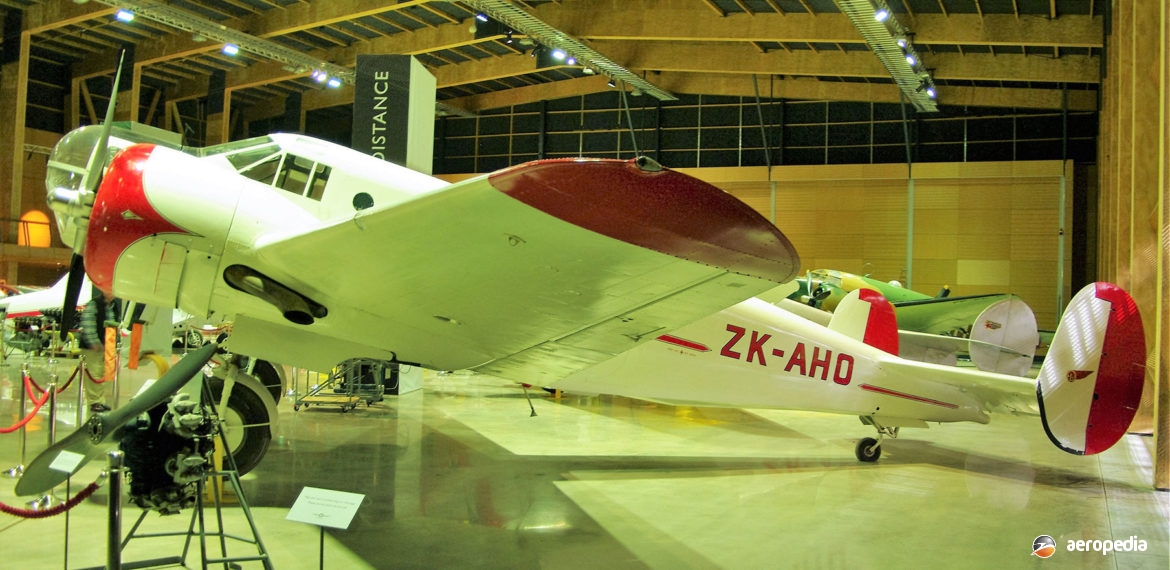Photograph:
Beech AT-11 Kansan ZK-AHO (c/n 3691) at the MOTAT Museum in Auckland, NZ (David C Eyre)
Country of origin:
United States of America
Description:
Twin-engine military navigation trainer
Power Plant:
Two 336 kw (450 hp) Pratt & Whitney R-985-AN-1 nine-cylinder air-cooled radial engines
Specifications:
- Wingspan: 14.53 m (47 ft 7 in)
- Length: 10.45 m (34 ft 3 in)
- Height: 2.98 m (9 ft 8 in)
- Wing area: 32.42 m² (349 sq ft)
- Max speed at 1,372 m (4,500 ft):346 km/h (215 mph)
- Max cruising speed: 325 km/h (202 mph)
- Economical cruising speed: 254 km/h (158 mph)
- Initial rate of climb: 351 m/min (1,150 ft/min)
- Time to 3,048 m (10,000 ft): 10.1 mins
- Service ceiling: 6,096 m (20,000 ft)
- Range: 1,400 km (870 miles)
- Empty weight: 2,801 kg (6,175 lb)
- Loaded weight: 3,959 kg (8,727 lb)
History:
The Kansan was initially known as the AT-11 and was developed in 1941 from the Beech 18 series for the military navigational training role, a late variant of the Model 18 series being used for this model. Previously known as the AT-7 (Advanced Trainer 7), it was developed from the B-18S which had been manufactured for the USAF. Installed therein were drift sights, chart tables and compasses to accommodate up to three navigation students. A large astrodrome was fitted for astro-navigational training. Some 884 examples of the AT-7 were delivered.
The AT-11, which was the most numerous model of the Beech 18 to serve with the US military, was also built as a bombardier and air-gunnery trainer, having the navigational equipment removed, a weapons bay built into the fuselage, underwing bomb racks and a re-designed nose to allow for a bomb aimer’s position to be inserted. This model also had flexibly-mounted machine-guns in the nose and dorsal positions for air-gunnery training.
In US Navy service the AT-11 became known as the SNB-1 while the AT-7 became the SNB-2 and SNB-2C. A total of 1,582 examples of the Kansan was built during the period from 1941 to 1943, and of these 36 were designated AT-11A navigation trainers.
After World War II many were disposed of to civil operators and foreign governments. Some remained with the US military as reserve aircraft, and 432 were re-manufactured by the Beech Corporation in the 1950s as the C-45H utility transport. A number remain in private operation in the United States.
New Zealand Aerial Mapping was formed in 1936 in Hastings by Piet van Asch and operated for 78 years before going into liquidation in 2014. The company initially operated a General Aircraft Monospar (ZK-AFF – Manu Rere) but an aircraft with higher performance was eventually required. In World War II the Monospar was involved in aerial mapping for the New Zealand Army, beginning in Auckland and covering Wellington, Christchurch and Waiouru. During the war the company was unique in operating the only civil registered aircraft allowed to fly.
In 1943, with the RNZAF involved in training of pilots, the New Zealand Government obtained one example of the Kansan ZK-AHO (c/n 3691 – ex 42-37208) which was operated by New Zealand Aerial Mapping. This aircraft was shipped to New Zealand in 1943 and assembled at RNZAF Hobsonville. Later that year it was taken to Union Airways where a camera mount was set up in the glass nose, and a 378 litre (83 Imp gal – 100 US gal) fuel tank was installed in the port bomb bay, this increasing endurance from 4½ hours to 7 hours. A darkroom was also constructed in the fuselage for the processing of film.
In 1944 the Kansan was involved in mapping work in the Pacific at the request of various island governments, and these surveys involved Fiji [Western and American], Tonga, Niue, the Solomon Islands and Norfolk Island. Named ‘Mani Ruuri’ (survey bird) it began survey and aerial mapping work in February 1944 and continued in service for 20 years until retired. It was eventually restored, donated and to and placed on display at the MOTAT Museum in Auckland. Aerial Mapping continued in this role for many years with more modern equipment until it closed down.

